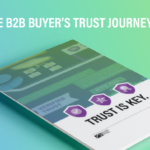Privacy, Personalization, and Big Data: How Privacy Changes Affect B2B Advertising

It may sound cliché, but tech is changing faster than ever before. Well, Big Tech specifically.
While the relentless pace of technological change is a given in 2022, corporate giants like Google are facing new challenges to previously-unchallenged advertising dominance. Consumer sentiment about privacy issues is at an all-time high. Government regulators worldwide are concerned about potential monopolistic abuse. Competitors like Apple are engaging in very public, messy spats about privacy and competing corporate agendas.
Amidst it all, Google’s desire to appease advertisers and keep its $200 billion advertising engine dominant – which accounts for 81% of its revenues – has never been higher. Google needs to strike a balance between providing an accurate measurement for advertisers and maintaining consumer privacy – not to mention burnishing its reputation amongst regulators. In what must be a new feeling for the search giant, Google finds itself caught in the middle.
In this article, we’ll look at the forces shaping digital advertising in 2022, what they mean for B2B healthcare advertisers, and what you can do to stay ahead of the times and keep your organization’s growth on a healthy trajectory.
How We Got Here:
Consumer desire for online privacy isn’t a new one, and neither is the debate on how to maintain a healthy advertising ecosystem while preserving privacy.
As far back as 2014, Pew Research found that 80% of Internet users said they were concerned about third parties like advertisers accessing the data they share online. 61% did not appreciate that online services may be more efficient because of increased access to personal data.
But in recent years, the rhetoric around privacy in advertising has reached a fever pitch.
According to an Axway study of 5,074 people, transparency is important: 9 out of 10 Internet users want to know the specific data that companies have collected about them. 85% of people are concerned that their online data may not be secure; a mere 37% feel that companies are transparent about the ways they use data online.
Perhaps nowhere is this concern more prevalent than when it comes to health-related information online. Just earlier this month, a scathing report from The Markup found that 33 out of the 100 largest health systems in the U.S. were sending sensitive patient data – perhaps one of the most highly-regulated pieces of personal information, thanks to HIPAA – back to Facebook.
“The question of how to preserve consumer privacy while maintaining accurate measurement for advertisers – and keeping regulators at bay – is an existential question for Google.”
Google and other advertising giants have suggested several changes to the systems they use to target ads and measure results in response to privacy concerns, but most of these efforts have fallen flat.
On a smaller scale, Google has introduced restrictions on the use of personalized advertising in certain restricted categories, such as healthcare, credit, housing, and employment. Also off-limits is the use of targeting settings for these categories in ways that could be considered discriminatory, such as allowing advertisers to target – or exclude – certain users from housing- or employment-related ads based on their race, gender, or ZIP code.
While these changes certainly affect advertisers in these industries, larger changes are afoot, too. The question of how to preserve consumer privacy while maintaining accurate measurement for advertisers – and keeping regulators at bay – is an existential question for Google.
Google has suggested changes to how it tracks users in response to the sea change in consumer sentiment. These changes hold vast implications for how advertisers of all stripes create compelling stories, target their most important prospects, and measure the success of their efforts in an increasingly privacy-focused world.
Third-Party Cookies are Dead. Long Live Third-Party Cookies
Ever since Google’s $3.1 billion acquisition of DoubleClick in 2007, third-party cookies have been the standard way of targeting prospects and measuring results online.
A third-party cookie is a small piece of code that is placed on a website by someone other than the owner (i.e. a third party), which collects user data for that third party. Like standard cookies, third-party cookies are designed to help the site remember something about the user at a later time.
Google Ads uses third-party cookies to monitor which websites are visited by a user. Over time, patterns emerge that help Google understand users: their interests, their purchase habits, their likely age, income ranges, and other factors. Of course, this data is extremely valuable to advertisers, as it helps them target precisely the right person.
Currently, third-party cookies are not only used for targeting, but for retargeting, audience building, cross-site tracking, and many other techniques that are staples in modern advertising campaigns.
But Third-Party Cookies are Dying:
Competing web browsers like Mozilla’s Firefox and Apple’s Safari have already done away with third-party cookies, and Google plans to remove them from their Chrome browser (which controls 60% of the global web browser market share) in 2024.
But doing so presents an existential question for Google: if the industry standard for tracking and targeting is dying, what replaces it? How can Google keep advertisers happy with their results, and keep its revenues high? What comes next?
FLoC: Federated Learning of Cohorts
Google’s first response to the death of third-party cookies was a product named FLoC, which stands for Federated Learning of Cohorts. FLoC was a proposed browser standard that would enable interest-based advertising on the web without letting advertisers know the exact identity of a user.
With FLoC, users’ browsing activity would be assigned to a “cohort” – a group of users sufficiently large enough to make them at least semi-anonymous to companies wanting to target them for advertising purposes. A user’s browsing history would be kept private and never shared, but on-device intelligence would assign the user to a cohort of similar people.
Advertisers would be able to see that a user was part of cohort 893455 for example, which would let them know that cohort 893455 was interested in artificial intelligence and EHR software. Since the cohort’s members would number in the thousands, it would supposedly be large enough to maintain some semblance of privacy – so the user’s specific identity would theoretically be protected.
But although it was ostensibly more privacy-focused, FLoC stalled over privacy concerns
FLoC still enabled fingerprinting, the practice of using data such as a device name, type, OS version, or IP address, to identify specific users. In a way, FLoC gave fingerprinters a massive head start: because a given cohort would only contain a few thousand users, trackers would only need to distinguish a user from a few thousand others (as opposed to hundreds of millions).
FLoC was widely decried by privacy advocacy groups like the Electronic Frontier Foundation and was even disabled by web browser maker Brave. In a move that was likely more PR-driven than anything else, Google has since claimed that they have found a better way to maintain measurement while preserving privacy: the Topics API.
Topics API: The Future of AdTech Targeting?
Google’s Topics API is designed to combat the shortcomings of FLoC and preserve privacy – but we’ll see how it works in practice.
With the Topics API, your browser will learn about you as you move around the web. It will retain the data about your browsing habits for the previous three weeks. After three weeks, you’ll be removed from that Topic and added to others that best reflect your recent browsing history.
Under this design, your browsing history will automatically let advertisers know about “Topics” you might be interested in.
When you browse a site that supports the Topics API, the browser will share three topics you’re interested in – one for each of the last three weeks – which are selected randomly from your top five topics for each week. The site can then share this with its advertising partners (like Google Ads) to decide which ads to display.
Topics are designed to be much looser than FLoC’s cohorts, and Chrome will add you to more than one Topic group based on your browsing. Google is limiting the number of topics to 300 to start, with plans to extend that number over time. Categories will be quite broad at launch, including Topics such as “sports”, “books”, “travel”, and “fitness”.
Categories this broad seldom lead to improved performance and are obviously a change from the granular ways advertisers are accustomed to targeting, so it remains to be seen how large Google’s pool of Topics will grow in time.
It should be noted that it’s up to other browser makers to support the Topics API, so the jury is still out (no major browser maker supported FLoC, after all.)
Also of note: Chrome will not use any browsing history stored in the cloud (everything is done on-device), so Topics can vary for the same user across their different devices. This presents additional challenges to cross-browser measurement and targeting that advertisers have come to rely on.
While Topics represent a win for privacy groups, they present a substantial challenge to advertisers: as the industry moves more toward leveraging artificial intelligence and big data, targeting prospective customers accurately becomes even more important. Gone are the days of manually bidding on super-specific keywords. Getting your message in front of the right prospect at the right time has never been more crucial.
But if the targeting tools at our disposal are changing, where do we turn?
How to Adapt Your Advertising in Today’s Privacy-Focused Landscape
Advertisers face a unique challenge in light of Big Tech’s privacy changes. The cultural desire for increased privacy isn’t going anywhere, so advertisers need to learn how to navigate uncharted waters to preserving privacy
We should note that since the Topics API hasn’t been fully rolled out yet, much remains to be seen. We simply don’t know just how much – if any – this move will hamstring the advertising industry. How will targeting change now that people will only be part of a “Topic” for a few weeks, and then drop off? What if Chrome is the only browser to support the Topics API – how can advertisers target the remaining 40% of the global browser market share that Google doesn’t control?
While questions abound, two things are clear: third-party cookies are going away, and advertisers will have to adjust their thinking about what ‘accurate targeting’ actually means.
Advertisers – and B2B advertisers in particular – should understand that a tectonic shift is happening.
In response, advertisers should prepare to move from the old way of thinking about targeting (”I need to reach the exact right person”) to a new model: “I need to get my message in front of the right type of person.”
Ostensibly, this is one of the benefits of Artificial Intelligence and Big Data: Google is hoping that advertisers will trust its machines to learn from patterns and target the right type of prospect better than any human advertiser ever could – and it’s hoping that’s enough to appease regulators.
Key Takeaway
More than anything, advertisers should focus on the story behind their products and services. The best targeting in the world won’t do much if the offer isn’t compelling. At the end of the day, the ads are just what introduces the product to the buyer – it’s the story that sells the product.
Targeting options might be changing, but a good story remains one of the most powerful weapons an advertiser can wield. As always in marketing, the best story wins.


